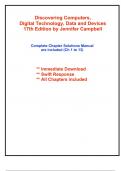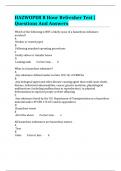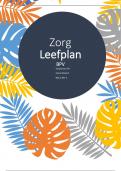Discovering Computers,
Digital Technology, Data and Devices
17th Edition by Jennifer Campbell
Complete Chapter Solutions Manual
are included (Ch 1 to 13)
** Immediate Download
** Swift Response
** All Chapters included
,Solution and Answer Guide
Jennifer T. Campbell, Discovering Computers 2023, 9780357675366; Module 1: Being a Digital
Citizen: At Home, School, and Work
TABLE OF CONTENTS
Study Guide ................................................................................................................................................. 1
Extend Your Knowledge ............................................................................................................................ 5
Checkpoint ................................................................................................................................................... 5
True/False ................................................................................................................................................. 5
Matching ................................................................................................................................................... 6
Problem Solving .......................................................................................................................................... 7
Personal ..................................................................................................................................................... 7
Professional ............................................................................................................................................... 8
Collaboration............................................................................................................................................. 9
How To: Your Turn .................................................................................................................................. 11
Internet Research ...................................................................................................................................... 11
Critical Thinking ....................................................................................................................................... 12
STUDY GUIDE
1. Define the term, digital literacy. What does it mean to be a digital citizen? Digital literacy, also known as
computer literacy, means having a current knowledge and understanding of computers, mobile
devices, the web, and related technologies. A digital citizen is a person familiar with how to use
technology to become and educated and productive member of the digital world.
2. Define the terms, computer, Internet, and online social network. A computer is an electronic device,
operating under the control of instructions stored in its own memory. The Internet is a global
collection of millions of computers linked together to share information. An online social network is
an online community where users can share their interest with other registered users.
3. Big Data refers to large and complex data sources that defy easy handling with traditional data processing
methods.
4. What are the negative effects of digital distraction? Digital distraction can lead to lower grades, strained
relationships, or danger of an injury or accident.
, 5. Explain the role of vacuum tubes, transistors, and integrated circuits in computer development. Vacuum
tools were used by the first generation of computers to control the flow of electrons. The next
generation of computers replaced vacuum tubes with transistors, which were smaller, cheaper, and
more reliable. Integrated circuits packed the equivalent of thousands of vacuum tubes or transistors
into a silicon chip.
6. How did the microprocessor contribute to the development of the PC? Microprocessors were even faster,
smaller, and less expensive than integrated circuits.
7. Define the Internet of Things. The Internet of Things is an environment in which processors are
embedded in every product imaginable that these things, in turn, communicate with each other via
the Internet or wireless networks.
8. Explain the role of embedded computers in IoT. List examples. Embedded computers enhance the
capabilities of everyday devices by performing a specific function. Examples include: a printer
monitoring ink levels, and in-vehicle cameras.
9. Chip-and-Pin technology stores data on a credit card’s embedded chip instead of a magnetic stripe.
10. Define kiosk. Describe its uses. A kiosk is a freestanding booth that contains a display device used to
show information. Kiosks enable self-serve transactions in hotels, airports, and also are used by
health care providers.
11. How does IoT affect home and business users? IoT enables you to manage devices remotely in your
home, such as starting your dishwasher from your phone. All businesses can use IoT; for example,
robotic arms for manufacturing, shipping companies tracking mileage and location of trucks, and
retail sensors used to track inventory.
12. Describe the digital divide, and how it is harmful. The digital divide is the gap between those who have
access to technology and its resources and information, and those who do not. Inequalities affect
learning, knowledge, and opportunities of those affected.
13. Explain how privacy has been impacted by technology. Data is collected on almost all actions and
transactions, such as web surfing, purchases, questionnaires, and more. Today it is virtually
impossible to remain private.
14. What privacy risks are involved with using technology? Attackers can target your personal information
by identity theft and steal your money or ruin your ability to receive a loan.
15. What is a data broker, and how do they access, collect, and sell your data? A data broker sells collected
data to third parties. They can access your data using social media, web history, credit card
applications or statements, and official records. They collect your name, address, age, social security,
and more. They sell your data you marketers and advertisers, fraud detection agencies, investment
officers, individual businesses, and government agencies.
16. Describe the effects of identity theft on the victim. How does identity theft occur, and what can you do to
prevent it? Identity theft involve using someone’s personal information to commit financial fraud to
obtain a credit card, for example. The victim suffers a damaged credit history. To prevent identify
theft, some guidelines include use encryption, shred financial paperwork, do not carry your Social
Security card in your wallet, and be careful about sharing personal information.






